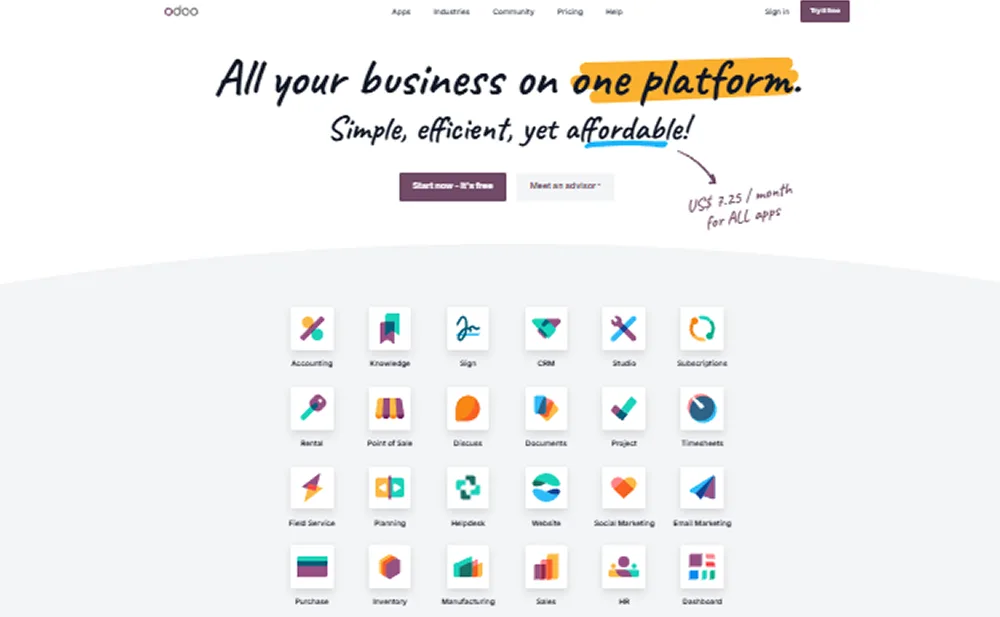Odoo (ERP Suite) Overview & 2025 Industry Position
Odoo (ERP Suite) has carved out a leading role in modular ERP systems by offering flexibility, scalability, and an ever-growing ecosystem. In 2025, it stands not just as an ERP solution, but as a digital command center for businesses spanning SMBs to mid-market enterprises. With AI-assisted workflows, unparalleled module customizations, and real-time cloud synchronization, Odoo is positioning itself as the go-to platform for a wide array of industries entering an era of post-pandemic digital transformation and compliance-heavy demands.
From Launch to 2025: Odoo (ERP Suite)’s Journey
Founded in 2005 under the name TinyERP, Odoo rebranded and expanded rapidly through multiple versions aimed at integrating business-critical apps into one seamless system. Key events in its history include:
- 2005: Launch of TinyERP in Belgium.
- 2009: Rebranded as OpenERP with a growing open-source community.
- 2014: Transformation to Odoo, introducing an app-based architecture.
- 2017: Odoo Enterprise gains traction with cloud and on-premise options.
- 2021–2023: Rapid growth driven by pandemic-era remote work tools and automation features.
- 2025: AI-enhanced modules, real-time multi-currency accounting, and low-code development capabilities.
For 2025, Odoo’s strategic focus is on AI-native business operations, offering embedded intelligence across modules to automate, predict, and optimize actions at scale.

Odoo (ERP Suite) Key Features
Odoo delivers one of the most comprehensive collections of business applications in the ERP space. Its key features include:
- Modular App Design: Over 50 core applications from accounting, CRM, inventory, HR, to project management, all integrated.
- AI Integration: Smart scheduling, predictive demand planning, and automated invoice matching powered by native AI engines.
- Website & eCommerce Builder: Low-code editor for creating client-facing digital properties that feed directly into CRM and Sales apps.
- Customer Portal: Dynamic, self-serve platform for invoices, orders, support tickets, and account info.
- Studio Interface: Visual app builder allowing non-technical users to customize fields, actions, and reports.
Workflow & UX
Odoo’s interface has matured considerably since its OpenERP days. The UX now features:
- Drag-and-drop Kanban & Gantt views across Sales, Projects, and MRP modules.
- In-app tutorials and automatic onboarding tailored to user roles.
- Centralized notification panel for approvals, tasks, and escalations.
- Smooth mobile-responsiveness with dedicated mobile apps for iOS and Android.
Odoo (ERP Suite) Pricing Analysis & Value Metrics
Pricing as of July 2025 follows a per-user, per-app model—and remains one of Odoo’s most competitive advantages.
| Plan | Monthly (Billed Annually) | Includes |
|---|---|---|
| One App Free Plan | $0 | 1 user, 1 app of choice |
| Standard | $25/user | Access to all apps, regular hosting, email support |
| Custom | From $37.40/user | Multi-company, advanced features, success packs |
Value Verdict: Odoo delivers extensive, enterprise-grade capabilities for less than half the cost of major competitors, especially when bundled with self-hosted options.
Competitive Landscape
| Platform | Ideal For | Pricing | Key Difference |
|---|---|---|---|
| Odoo | Modular SMB to Mid-Market | From Free | Modular pricing + open customizations |
| NetSuite | Upper Mid-Market, Enterprise | from $999 base | Deeper verticalization |
| QuickBooks + Apps | Small Business | $15–150 | Financial-first stack, limited integrations |
| Zoho One | Small Teams, Tech Startups | $37/user | Tight SaaS ecosystem, fewer ERP modules |
Odoo (ERP Suite) Use Cases
Where Odoo (ERP Suite) shines especially bright is in multi-function or multi-role organizations who need:
- One system that combines POS, Inventory, and Accounting for retail/hospitality outlets
- B2B CRM + Web + Quoting + Contracts workflows for service firms
- Manufacturing resource planning (MRP) with built-in barcode logistics
- HR + Payroll + Time-Off management in global/multi-region setups
Integrations & Ecosystem
With over 39,000 apps in the Odoo store—plus native integrations—users benefit from one of the most robust ERP ecosystems available:
- eCommerce platforms: Shopify, WooCommerce
- Accounting: Plaid, Stripe, PayPal, Square
- HR: LinkedIn, BambooHR, ZipRecruiter
- Banking: Real-time bank feeds + reconciliations
- CRMs and Marketing: Mailchimp, Google Ads, HubSpot
Pro Tip: Take advantage of Odoo Studio to visually build and brand custom workflows without writing a single line of code!
Pros & Cons
- Pros:
- Highly modular and scalable across industries
- Affordable plans with no vendor lock-in
- Clean design and customizable workflows
- Massive app ecosystem with continuous innovation
- Cons:
- Customization may require steep internal learning or dev help
- Some support tiers are only available at higher pricing plans
- Not ideal for hyper-narrow verticals with niche compliance
Final Thoughts
The 2025 edition of Odoo (ERP Suite) stands as a category leader in flexible ERP. With increasing emphasis on AI-driven features and deep integrations, it’s ideal for businesses scaling beyond entry-level apps but not yet ready for costly enterprise stacks. Whether you’re retail, B2B, or logistics-minded, Odoo (ERP Suite) CRM, Payroll, and Inventory workflows offer unbeatable agility.
Odoo (ERP Suite) FAQ
Yes, Odoo offers a Community edition that is open-source with limited features. The Enterprise edition is proprietary but offers full functionality and support.
Yes, Odoo supports both Odoo Cloud (hosted) and on-premise deployments, particularly appealing to IT-sensitive industries.
The free plan allows one app of choice with unlimited features for a single user. Great for testing core workflows before scaling.
Yes. Email and live chat support is available for Enterprise plans. Priority response and onboarding help incur additional fees.
Yes, Odoo offers mobile apps for iOS and Android that sync with desktop workflows and support offline inventory updates.